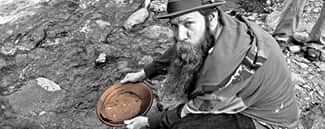How To Make Gold Test Solution

A solution of Stannous Chloride called “Purple of Cassius” has been used for centuries by gold prospectors to test for the presence of gold in a solution. It would give them a rough idea of how rich the gold is in the ore deposit. This is determined by the color of the reaction that could range from a light pink to a dark purple. The darker the purple, the richer the gold ore.
This Gold Test Solution is easy to make and you should not make a lot at one time as the ‘shelf life’ is not long.
You will need:
- Our Stannous Chloride Test Solution Kit. Kit includes...
- 25g Stannous Chloride
- 12.5g Pure Tin Metal Shot
- 1 pre-labeled 1oz Amber Dropper Bottle
- Instruction sheet
- Concentrated Hydrochloric Acid.
- Tap Water.
Prepare the test solution per the included instructions.
STANNOUS CHLORIDE TESTING SOLUTION
Following is adapted from, “Refining Precious Metal Wastes” by C. M Hoke
When properly applied, this solution is extremely useful in revealing the presence of gold, silver, platinum, iridium and palladium in solution. Some idea of the proportions in which they are present can also be deduced. It is easy to make, requiring only a small amount of stannous chloride crystals, and a smaller amount of pure tin metal—mossy, granular, or foil. You will also need some hydrochloric acid and a 1 oz (30mL) dropping bottle.
How to Make the Testing Solution
Make up only a little of the Testing Solution at a time, as it does not keep well. Take about a pennyweight (~1.6g) or less of the stannous chloride crystals in the dropping bottle, add a half pennyweight (~0.8g) or so of tin metal, and fill the bottle ¾’s full of water. Tap water will do. Now add about 20 to 30 drops of hydrochloric acid, more or less, to a 30 mL bottle. This gives a milky liquid that is ready to use. The tin metal will dissolve very slowly, and it serves to keep the solution in good condition. Label the bottle "SnCl2 Testing Solution"
STANNOUS CHLORIDE TESTING SOLUTION WITH PLATINUM
Add a drop or more of the Testing Solution to a spot plate or ceramic streak plate containing a small amount of your unknown metal solution. Notice the color –
- Pale yellow color indicates a weak solution of platinum. Add a few more drop of the Testing Solution
- A deep yellow or brown color indicates a stronger platinum solution.
- A black reaction indicates a very concentrated platinum solution
- A deep yellow color with the Test Solution is a characteristic of platinum and iridium.
WITH GOLD
With a small sample of your unknown metal solution on a spot plate, add a drop of the Test Solution. After several moments add several more drops of the Test Solution. Note the first intense dark color, deep purple or black. This is characteristic of gold. After it stands a few minutes, notice the purple stain on the white porcelain. Do not let the liquids dry on the plate. Wash it promptly after each test, removing any stains with a drop of aqua regia and rinsing well. This test is very sensitive to gold. Even very low concentrations will show a purple reaction.
WITH PALLADIUM
This color change is even more interesting than the others. When a drop of Test Solution is mixed with your metal solution, you see a deep yellow, not unlike the effect produced by platinum. After some minutes the yellow turns blue-green. This blue-green color is characteristic of palladium.
WITH SILVER
Silver solutions, such as silver nitrate, do not give any color-reaction with the Testing Solution. What you will see when the two solutions are mixed is a white cheesy precipitate of silver chloride, similar to that obtained when table salt is added to a silver nitrate solution.
WITH BASE METALS
Solutions containing only such base metals as iron, copper, zinc, nickel and cadmium give no color change with stannous chloride. Lead may give a white precipitate that looks like silver chloride, but if you employed the dichromate test* this will cause you no confusion.
*Dichromate Test for Silver:
Mix up nitric acid and a few crystals of potassium dichromate in a 1oz dropper bottle. Place a drop of this solution on the suspected article (after getting rid of lacquer, etc.) and note the color effect. Silver will show a very strong, definite red, through the formation of silver dichromate.


